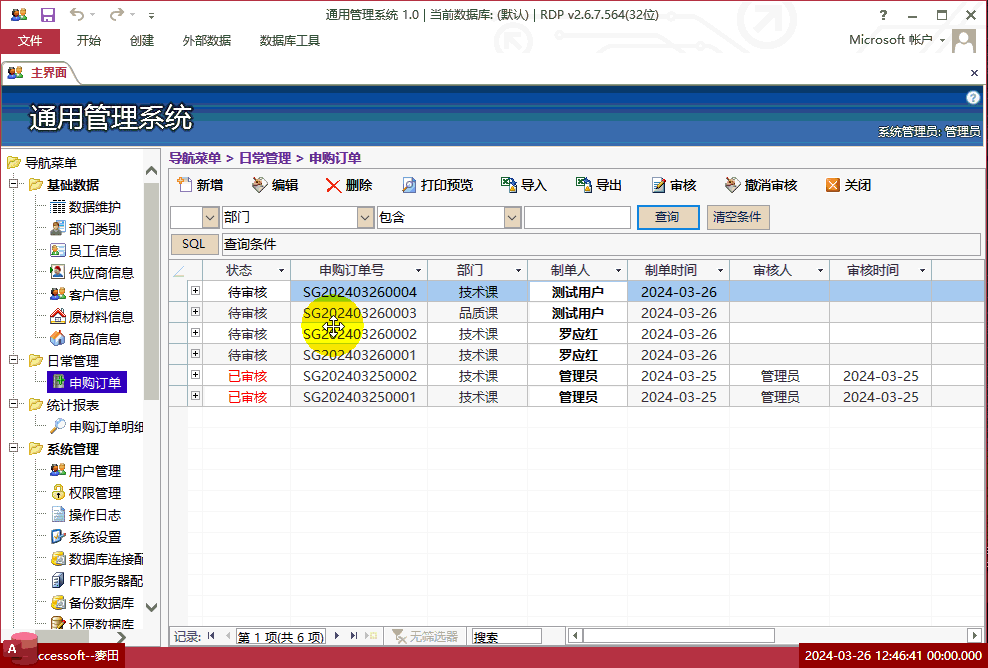携自动功能之利,通过access使用PowerPoint演示文稿
时 间:2009-03-03 10:45:05
作 者:AccessHome整理 ID:563 城市:上海
摘 要:适用于:
Microsoft Office Access 2000 or later
Microsoft Office PowerPoint 2003
使用 Access 数据,从头创建 PowerPoint 幻灯演示文稿。此外,在 Access 窗体中显示并控制幻灯片放映。演练解决方案,并探索将示例扩展到自己的应用程序的方法。
正 文:
本文探讨两种在 Access 和 PowerPoint 之间的交互方法。第一个示例描述如何利用自动功能使用 Access 表的数据来创建 PowerPoint 演示文稿。第二个示例说明,同样利用自动功如何在 Access 窗体中显示和操纵现有的 PowerPoint 演示文稿。通过操纵受控应用程序的公开属性和方法并响应事件,自动功能使您能够从不同的应用程序来控制一个应用程序。
从 Access 数据创建 PowerPoint 演示文稿
本示例通过 Access 数据创建一个幻灯演示文稿。Recordset 对象由表中的数据创建。然后,使用记录集中的数据填充幻灯片。
要创建幻灯片,请执行以下步骤:
-
启动 Access 并打开任一数据库。
-
在“设计”视图中,创建以下带有所示控件的窗体,使其不依赖于任何表或查询:
Form: CreateFromAccessData
Caption: PowerPoint Demo
Command Button: cmdPowerPoint
-
Name: cmdPowerPoint
-
Caption: PowerPoint Example
-
Width: 2"
-
-
在 View 菜单上,单击 Code。
-
在 Tools 菜单上,单击 References。
-
在 Available References 框中,单击 Microsoft PowerPoint 9.0 Object Library 和 Microsoft Office 9.0 Object Library。
-
单击 OK 关闭 References 对话框。
-
将下面的代码行添加到 General Declarations 部分:
Option Explicit
-
键入或粘贴以下过程:
Sub cmdPowerPoint_Click() Dim db As Database, rs As Recordset Dim ppObj As PowerPoint.Application Dim ppPres As PowerPoint.Presentation On Error GoTo err_cmdOLEPowerPoint ' Open up a recordset on the Employees table. Set db = CurrentDb Set rs = db.OpenRecordset("Employees", dbOpenDynaset) ' Open up an instance of Powerpoint. Set ppObj = New PowerPoint.Application Set ppPres = ppObj.Presentations.Add ' Setup the set of slides and populate them with data from the ' set of records. With ppPres While Not rs.EOF With .Slides.Add(rs.AbsolutePosition + 1, ppLayoutTitle) .Shapes(1).TextFrame.TextRange.Text = "Hi! Page " & rs.AbsolutePosition + 1 .SlideShowTransition.EntryEffect = ppEffectFade With .Shapes(2).TextFrame.TextRange .Text = CStr(rs.Fields("LastName").Value) .Characters.Font.Color.RGB = RGB(255, 0, 255) .Characters.Font.Shadow = True End With .Shapes(1).TextFrame.TextRange.Characters.Font.Size = 50 End With rs.MoveNext Wend End With ' Run the show. ppPres.SlideShowSettings.Run Exit Sub err_cmdOLEPowerPoint: MsgBox Err.Number & " " & Err.Description End Sub -
保存这个 PowerPointDemo 窗体,并在“窗体”视图中打开它。
-
单击 PowerPoint Example。
注意,该 PowerPoint 幻灯片放映在您的屏幕上创建并进行显示。单击鼠标,在幻灯片间移动。
利用自动功能在窗体中显示 PowerPoint 演示文稿
该示例为您说明如何在 Access 的窗体上显示 PowerPoint 中的幻灯片。该技术使用 Access 中的自动功能来打开 PowerPoint 演示文稿并链接至第一张幻灯片。通过更改 SourceItem 属性(使您能够链接至不同幻灯片),可查看其他幻灯片。
注 要使用这项技术,计算机上必须安装有 PowerPoint 和 Access。还需要创建一个 PowerPoint 演示文稿 (.ppt)。在该过程中,用您自己文件的名称及路径替换以下文件名:
C:\Program Files\Microsoft Office\Office\Pptexample.ppt
作为提供的下载示例,其中包含一个示例演示文稿。
下面的示例创建一个窗体,该窗体具有一个未绑定的对象框控件和五个命令按钮,以链接至 PowerPoint 演示文稿并在其幻灯片之间移动。
要在窗体中显示 Microsoft PowerPoint 幻灯片,请遵循以下步骤:
-
在新的 Access 数据库中,在“设计”视图中创建一个窗体。
-
将以下五个控件添加至该窗体:
命令按钮
-
Name: insertShow
-
Caption: Get Presentation
-
Enabled: Yes
命令按钮
-
Name: frstSlide
-
Caption: First Slide
-
Enabled: No
命令按钮
-
Name: nextSlide
-
Caption: Next Slide
-
Enabled: No
命令按钮
-
Name: previousSlide
-
Caption: Previous Slide
-
Enabled: No
命令按钮
-
Name: lastSlide
-
Caption: Last Slide
-
Enabled: No
-
-
向该窗体添加一个未绑定的对象框控件。在 Insert Object 框中,单击 Create New button,选择 Bitmap Image 作为对象类型,然后单击 OK。注意,该对象框在窗体上为一块空白空间。
-
显示未绑定对象框的属性表,然后设置属性(如下所示):
未绑定对象框
-
Name: pptFrame
-
SizeMode: Zoom
-
Enabled: Yes
-
Locked: No
-
-
在 View 菜单上,单击 Code 打开窗体模块。
-
将以下代码添加到 General Declarations 部分:
Option Explicit ' Initialize variables. Private mcolSlideIDs As Collection Private mlngSlideIndex As Long
-
在 Object 列表中,单击 insertShow。在 Procedure 列表中,单击 Click,然后添加以下代码:
Private Sub insertShow_Click() On Error GoTo insertShow_Click_Error ' Open PowerPoint Dim strPowerPointFile As String Dim pptobj As PowerPoint.Application Set pptobj = New PowerPoint.Application pptobj.Visible = True pptobj.WindowState = ppWindowMinimized strPowerPointFile = CurrentProject.Path & "\Access2PowerPoint.ppt" ' Fill a collection with all Slide IDs. With pptobj.Presentations.Open(strPowerPointFile) Set mcolSlideIDs = New Collection Dim ppSlide As PowerPoint.Slide For Each ppSlide In .Slides mcolSlideIDs.Add ppSlide.SlideID Next .Close End With ' Close PowerPoint pptobj.Quit Set pptobj = Nothing ' Make object frame visible and enable "navigation" buttons. pptFrame.Visible = True frstSlide.Enabled = True lastSlide.Enabled = True nextSlide.Enabled = True previousSlide.Enabled = True ' Specify OLE Class, Type, SourceDoc, SourceItem and other properties. With pptFrame .Class = "Microsoft Powerpoint Slide" .OLETypeAllowed = acOLELinked .SourceDoc = strPowerPointFile End With SetSlide 1 frstSlide.SetFocus insertShow.Enabled = False Exit Sub insertShow_Click_Error: MsgBox Err.Number & " " & Err.Description Exit Sub End Sub -
在 Object 列表中,单击 frstSlide。在 Procedure 列表中,单击 Click,然后添加以下代码:
Private Sub frstSlide_Click() SetSlide 1 End Sub -
在 Object 列表中,单击 lastSlide。在 Procedure 列表中,单击 Click,然后添加以下代码:
Private Sub lastSlide_Click() SetSlide mcolSlideIDs.Count End Sub -
在 Object 列表中,单击 nextSlide。在 Procedure 列表中,单击 Click,然后添加以下代码:
Private Sub nextSlide_Click() SetSlide mlngSlideIndex + 1 End Sub -
在 Object 列表中,单击 previousSlide。在 Procedure 列表中,单击 Click,然后添加以下代码:
Private Sub previousSlide_Click() SetSlide mlngSlideIndex - 1 End Sub -
添加以下过程:
Private Sub SetSlide(ByVal ID As Integer) On Error GoTo ErrorHandler Select Case ID Case Is > mcolSlideIDs.Count MsgBox "This is the last slide." Case 0 MsgBox "This is the first slide." Case Else mlngSlideIndex = ID With pptFrame .SourceItem = mcolSlideIDs(mlngSlideIndex) .Action = acOLECreateLink End With End Select Exit Sub ErrorHandler: MsgBox Err.Number & " " & Err.Description Exit Sub End Sub -
关闭并保存该窗体模块。
-
将该窗体切换至“窗体”视图,然后单击 Get Presentation。接下来,单击其他按钮以在演示文稿中移动。
本文示范了利用自动功能来使用 Access 和 PowerPoint。这使您能够在 Access 内创建幻灯演示文稿,并在 Access 窗体内使用现有 PowerPoint 演示文稿。使用诸如此类的技术,使您能够将以往需要手动执行的任务进行自动化,从而节省时间并让自己的应用程序更显专业化。
Access软件网官方交流QQ群 (群号:54525238) Access源码网店
常见问答:
技术分类:
源码示例
- 【源码QQ群号19834647...(12.17)
- 用Access连续窗体制作的树...(11.03)
- 【Access高效办公】上一年...(10.30)
- Access制作的RGB转CM...(09.22)
- Access制作的RGB调色板...(09.15)
- Access制作的快速车牌输入...(09.13)
- 【Access高效办公】统计当...(06.30)
- 【Access高效办公】用复选...(06.24)
- 根据变化的日期来自动编号的示例...(06.20)
- 【Access高效办公】按日期...(06.12)

学习心得
最新文章
- Access快速开发平台--2.6...(12.24)
- Access快速开发平台企业版--...(12.10)
- SqlServer默认当前时间用什...(11.28)
- 【Access日期时间区间段查询示...(11.19)
- Microsoft Access不...(11.07)
- 用Access连续窗体制作的树菜单...(11.03)
- 【Access高效办公】上一年度累...(10.30)
- Access做的一个《中华经典论语...(10.25)
- Access快速开发平台--加载事...(10.20)
- 【Access有效性规则示例】两种...(10.10)




.gif)

